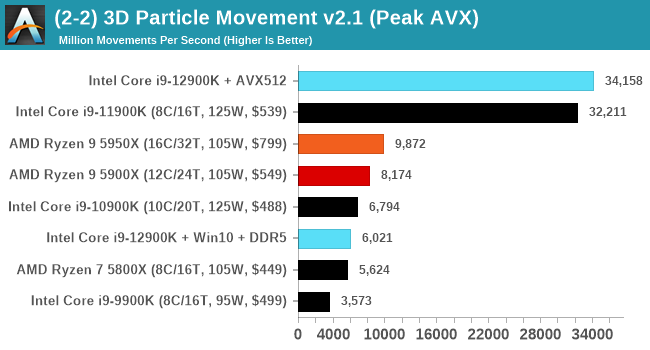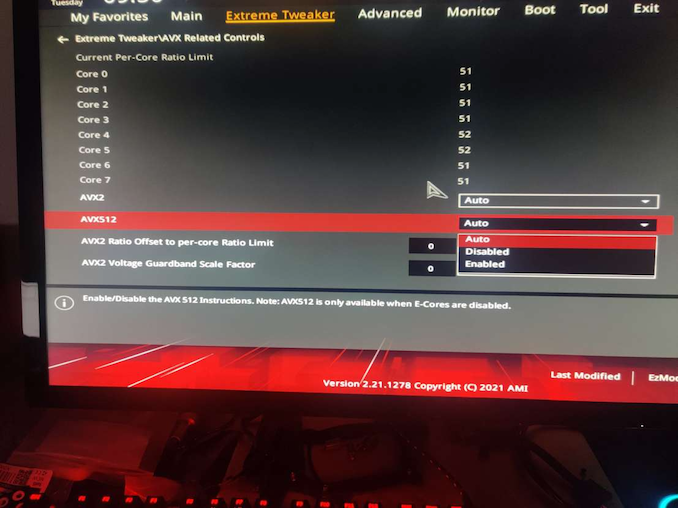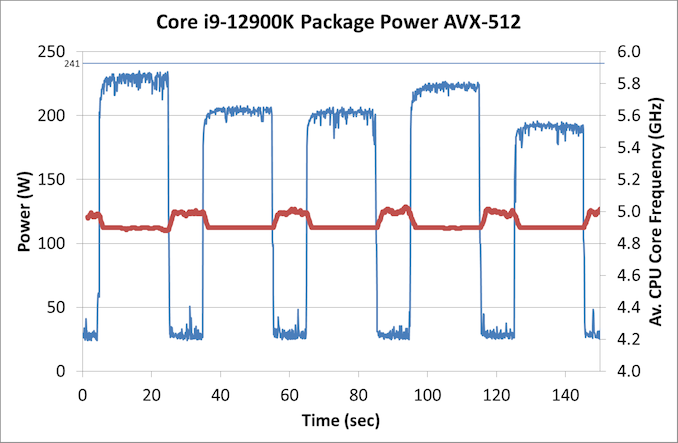The Intel 12th Gen Core i9-12900K Review: Hybrid Performance Brings Hybrid Complexity
by Dr. Ian Cutress & Andrei Frumusanu on November 4, 2021 9:00 AM ESTIntel Disabled AVX-512, but Not Really
One of the more interesting disclosures about Alder Lake earlier this year is that the processor would not have Intel’s latest 512-bit vector extensions, AVX-512, despite the company making a big song and dance about how it was working with software developers to optimize for it, why it was in their laptop chips, and how no transistor should be left behind. One of the issues was that the processor, inside the silicon, actually did have the AVX-512 unit there. We were told as part of the extra Architecture Day Q&A that it would be fused off, and the plan was for all Alder Lake CPUs to have it fused off.
Part of the issue of AVX-512 support on Alder Lake was that only the P-cores have the feature in the design, and the E-cores do not. One of the downsides of most operating system design is that when a new program starts, there’s no way to accurately determine which core it will be placed on, or if the code will take a path that includes AVX-512. So if, naively, AVX-512 code was run on a processor that did not understand it, like an E-core, it would cause a critical error, which could cause the system to crash. Experts in the area have pointed out that technically the chip could be designed to catch the error and hand off the thread to the right core, but Intel hasn’t done this here as it adds complexity. By disabling AVX-512 in Alder Lake, it means that both the P-cores and the E-cores have a unified common instruction set, and they can both run all software supported on either.
There was a thought that if Intel were to release a version of Alder Lake with P-cores only, or if a system had all the E-cores disabled, there might be an option to have AVX-512. Intel shot down that concept almost immediately, saying very succinctly that no Alder Lake CPU would support AVX-512.
Nonetheless, we test to see if it is actually fused off.
On my first system, the MSI motherboard, I could easily disable the E-cores. That was no problem, just adjust the BIOS to zero E-cores. However this wasn’t sufficient, as AVX-512 was still clearly not detected.
On a second system, an ASUS motherboard, there was some funny option in the BIOS.
Well I’ll be a monkey’s uncle. There’s an option, right there, front and centre for AVX-512. So we disable the E-cores and enable this option. We have AVX-512 support.
For those that have some insight into AVX-512 might be aware that there are a couple of dozen different versions/add-ons of AVX-512. We confirmed that the P-cores in Alder Lake have:
- AVX512-F / F_X64
- AVX512-DQ / DQ_X64
- AVX512-CD
- AVX512-BW / BW_X64
- AVX512-VL / VLBW / VLDQ / VL_IFMA / VL_VBMI / VL_VNNI
- AVX512_VNNI
- AVX512_VBMI / VBMI2
- AVX512_IFMA
- AVX512_BITALG
- AVX512_VAES
- AVX512_VPCLMULQDQ
- AVX512_GFNI
- AVX512_BF16
- AVX512_VP2INTERSECT
- AVX512_FP16
This is, essentially, the full Sapphire Rapids AVX-512 support. That makes sense, given that this is the same core that’s meant to be in Sapphire Rapids (albeit with cache changes). The core also supports dual AVX-512 ports, as we’re detecting a throughput of 2 per cycle on 512-bit add/subtracts.
For performance, I’m using our trusty 3DPMAVX benchmark here, and compared to the previous generation Rocket Lake (which did have AVX-512), the score increases by a few percent in a scenario which isn’t DRAM limited.

Now back in that Rocket Lake review, we noted that the highest power consumption observed for the chip was during AVX-512 operation. At that time, our testing showcased a big +50W jump between AVX2 and AVX-512 workloads. This time around however, Intel has managed to adjust the power requirements for AVX-512, and in our testing they were very reasonable:
In this graph, we’re showing each of the 3DPM algorithms running for 20 seconds, then idling for 10 seconds. Each one has a different intensity of AVX-512, hence why the power is up and down. IN each instance, the CPU used an all-core turbo frequency of 4.9 GHz, in line with non-AVX code, and our peak power observed is actually 233 W, well below the 241 W rated for processor turbo.
Why?
So the question then refocuses back on Intel. Why was AVX-512 support for Alder Lake dropped, and why were we told that it is fused off, when clearly it isn’t?
Based on a variety of conversations with individuals I won’t name, it appears that the plan to have AVX-512 in Alder Lake was there from the beginning. It was working on early silicon, even as far as ES1/ES2 silicon, and was enabled in the firmware. Then for whatever reason, someone decided to remove that support from Intel’s Plan of Record (POR, the features list of the product).
By removing it from the POR, this means that the feature did not have to be validated for retail, which partly speeds up the binning and testing/validation process. As far as I understand it, the engineers working on the feature were livid. While all their hard work would be put to use on Sapphire Rapids, it still meant that Alder Lake would drop the feature and those that wanted to prepare for Alder Lake would have to remain on simulated support. Not only that, as we’ve seen since Architecture Day, it’s been a bit of a marketing headache. Whoever initiated that dropped support clearly didn’t think of how that messaging was going to down, or how they were going to spin it into a positive. For the record, removing support isn’t a positive, especially given how much hullaballoo it seems to have caused.
We’ve done some extensive research on what Intel has done in order to ‘disable’ AVX-512. It looks like that in the base firmware that Intel creates, there is an option to enable/disable the unit, as there probably is for a lot of other features. Intel then hands this base firmware to the vendors and they adjust it how they wish. As far as we understand, when the decision to drop AVX-512 from the POR was made, the option to enable/disable AVX-512 was obfuscated in the base firmware. The idea is that the motherboard vendors wouldn’t be able to change the option unless they specifically knew how to – the standard hook to change that option was gone.
However, some motherboard vendors have figured it out. In our discoveries, we have learned that this works on ASUS, GIGABYTE, and ASRock motherboards, however MSI motherboards do not have this option. It’s worth noting that all the motherboard vendors likely designed all of their boards on the premise that AVX-512 and its high current draw needs would be there, so when Intel cut it, it meant perhaps that some boards were over-engineered with a higher cost than needed. I bet a few weren’t happy.
Update: MSI reached out to me and have said they will have this feature in BIOS versions 1.11 and above. Some boards already have the BIOS available, the rest will follow shortly.
But AVX-512 is enabled, and we are now in a state of limbo on this. Clearly the unit isn’t fused off, it’s just been hidden. Some engineers are annoyed, but other smart engineers at the motherboard vendors figured it out. So what does Intel do from here?
First, Intel could put the hammer down and execute a scorched earth policy. Completely strip out the firmware for AVX-512, and dictate that future BIOS/UEFI releases on all motherboards going forward cannot have this option, lest the motherboard manufacturer face some sort of wrath / decrease in marketing discretionary funds / support. Any future CPUs coming out of the factory would actually have the unit fused out, rather than simply turned off.
Second, Intel could lift the lid, acknowledge that someone made an error, and state that they’re prepared to properly support it in future consumer chips with proper validation when in a P-core only mode. This includes the upcoming P-core only chips next year.
Third, treat it like overclocking. It is what it is, your mileage may vary, no guarantee of performance consistency, and any errata generated will not be fixed in future revisions.
As I’ve mentioned, apparently this decision didn’t go down to well. I’m still trying to find the name of the person/people who made this decision, and get their side of the story as to technically why this decision was made. We were told that ‘No Transistor Left Behind’, except these ones in that person’s mind, clearly.












474 Comments
View All Comments
mode_13h - Saturday, November 6, 2021 - link
> So, Alder Lake is a turkey as a high-end CPU, one that should have never been released?How do you reach that conclusion, after it blew away its predecessor and (arguably) its main competitor, even without AVX-512?
> This is because each program has to include Alder Lake AVX-512 support and
> those that don’t will cause performance regressions?
No, my point was that relying on the OS to trap AVX-512 instructions executed on E-cores and then context-switch the thread to a P-core is likely to be problematic, from a power & performance perspective. Another issue is code which autodetects AVX-512 won't see it, while running on an E-core. This can result in more than performance issues - it could result in software malfunctions if some threads are using AVX-512 datastructures while other threads in the same process aren't. Those are only a couple of the issues with enabling heterogeneous support of AVX-512, like what some people seem to be advocating for.
> Is Windows 11 able to support a software utility to disable the low-power cores
> once booted into Windows or are we restricted to disabling them via BIOS?
That's not the proposal to which I was responding, which you can see by the quote at the top of my post.
Oxford Guy - Sunday, November 7, 2021 - link
So, you’ve stated the same thing again — that Intel knew Alder Lake couldn’t be fully supported by Windows 11 even before it (AL) was designed?The question about the software utility is one you’re unable to answer, it seems.
mode_13h - Sunday, November 7, 2021 - link
> The question about the software utility is one you’re unable to answer, it seems.That's not something I was trying to address. I was only responding to @SystemsBuilder's idea that Windows should be able to manage having some cores with AVX-512 and some cores without.
If you'd like to know what I think about "the software utility", that's a fair thing to ask, but it's outside the scope of what I was discussing and therefore not a relevant counterpoint.
Oxford Guy - Monday, November 8, 2021 - link
More hilarious evasion.mode_13h - Tuesday, November 9, 2021 - link
> More hilarious evasion.Yes, evasion of your whataboutism. Glad you enjoyed it.
GeoffreyA - Sunday, November 7, 2021 - link
"So, Intel designed and released a CPU that it knew wouldn’t be properly supported by Windows 11"Oxford Guy, there's a difference between the concerns of the scheduler and that of AVX512. Alder Lake runs even on Windows 10. Only, there's a bit of suboptimal scheduling there, where the P and E cores are concerned.
If AVX512 weren't disabled, it would've been something of a nightmare keeping track of which cores support it and which don't. Usually, code checks at runtime whether a certain set of instructions---SSE3, AVX, etc---are available, using the CPUID instruction or intrinsic. Stir this complex yeast into the soup of performance and efficiency cores, and there will be trouble in the kitchen.
Under this is new, messy state of affairs, the only feasible option mum had, or should I say Intel, was bringing the cores onto a equal footing by locking AVX512 in the attic, and saying, no, that fellow doesn't live here.
GeoffreyA - Sunday, November 7, 2021 - link
Also, Intel seems pretty clear that it's disabled and so forth. Doesn't seem shady or controversial to me:https://www.intel.com/content/www/us/en/developer/...
SystemsBuilder - Saturday, November 6, 2021 - link
Thinking a bit about what you wrote: "This will not happen". And it is not easy but possible… it’s a bit technical but here we go… sorry for the wall of text.When you optimize code today (for pre Alder lake CPUs) to take advantage of AVX-512 you need to write two paths (at least). The application program (custom code) would first check if the CPU is capable of AVX-512 and at what level. There are many levels of AVX-512 support and effectively you need write customized code for each specific CPUID (class of CPUs , e.g. Ice lake, Sky lake X etc.) since for whatever CPU you end up running this particular program on, you would want to utilize the most favorable/relevant AVX-512 instructions. So with the custom code today (Pre Alder lake) the scheduler would just assign a tread to a underutilized core (loosely speaking) and the custom code would check what the core is capable off and then chose best path in real time (AVX2 and various level of AVX-512). The problem is that with Alder Lake not all cores are equal! BUT the custom code should have various paths already so it is capable!… the issue that I see is that the custom code CPU check needs to be adjusted to check core specific capability not CPUID specific (one more level of granularity) AND the scheduler should schedule code with AVX-512 paths on AVX-512 capable cores by preference... what’s needed is a code change in the AVX-512 path selection logic ( on the application developer - not a big deal) and compiler support that embed scheduler specific information about if the specific piece of code prefers AVX-512 or not. The scheduler would then use this information to schedule real time and the custom code would be able to choose the right path at execution time.
It is absolutely possible and it will come with time.
I think this is that this is not just applicable to AVX-512. I think in the future P and E cores might have more than just AVX-512 that is different (they might diverge much more than that) so the scheduler needs to be made aware of what a thread prefers and what the each core is capable of before it schedules each tread. It is the responsibility of the custom code to have multiple paths (if they want to utilize AVX-512 or not).
SystemsBuilder - Saturday, November 6, 2021 - link
old .exe which are not adjusted and are not recompiled for Alder Lake (code does not recognize Alder Lake) would simply automatically regress to AVX2 and the scheduler would not care which CPU to schedule it on. Basically that is what's happening today if you do not enable AVX-512 in the ASUS bios.Net net: you could make it would work.
mode_13h - Saturday, November 6, 2021 - link
> old .exe which are not adjusted and are not recompiled for Alder Lake (code does> not recognize Alder Lake) would simply automatically regress to AVX2
So, like 98% of shipping AVX-512 code, by the time Raptor Lake is introduced?
What you're proposing is a lot of work for Microsoft, only to benefit a very small number of applications. I think Intel would rather that people who need those apps simply buy CPU which officially support AVX-512 (or maybe switch off their E-cores and enable AVX-512 in BIOS).